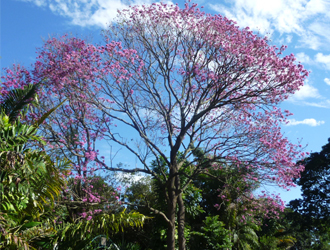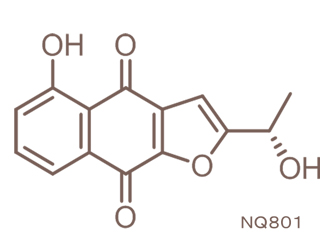What is Taheebo?
 Ecosystem in the Amazonian tropic forest of South America is very complicated has rich vegetation. There are more than 5000 kinds of medicinal plants. Only discovered kinds to date is at least 2500.
Ecosystem in the Amazonian tropic forest of South America is very complicated has rich vegetation. There are more than 5000 kinds of medicinal plants. Only discovered kinds to date is at least 2500.
Among them, Taheebo is called ‟the grace of God‟ and taken in as medically effective tree.
‟Taheebo tea” made from Taheebo’s inner bark, has been drunken among native tribes in South America for several thousand years through the ancient Incan Emperor, Andes civilizations such as pre-Incan civilization (Chavín, Chimú and Moche) and Amazonian cultural region.
Row wood of Taheebo
 Taheebo, whose scientific name is Tabebuia avellanedae of Bignonia family, has purplish-red flowers. Most effective Taheebo tea is made only from its inner bark.
Taheebo, whose scientific name is Tabebuia avellanedae of Bignonia family, has purplish-red flowers. Most effective Taheebo tea is made only from its inner bark.
This tree grows in Amazonian jangle and it is difficult to grow in urban area. Therefore, there are few in city. Row Taheebo wood that naturally grows in Amazonian tropic forest is a tree of 30-40 m in height and 1.5-2 m in width.
Trunk tissue is thick and hard, and therefore it is difficult to cut by chainsaw. As it abundantly absorbs minerals, it is too heavy to float in water. As it is deep-rooted, it won’ t fall down by squall or storm. If stump is left in a hot and humid jungle, it won’t decay. Because of its strength, toughness and amazing power, people believe that Taheebo is the grace of God.
Purple Ipe is not Taheebo.
Taheebo scientifically belongs to the Tabebuia genus, Bignonia family. This type of plant is called ‟Ipe” in Brazil.
There are more than 750 kinds of Bignonia family around the world. Here in Japan, there are trumpet creeper, yellow catalpa and princess tree, and so on.
Among them, there are more than 100 kinds of Tabebuia genus in North and South America continents and they are classified into 3 classes by flower color: White Ipe (Ipe-branco), Yellow Ipe (Ipe-amarelo), and Purple Ipe (Ipe-roxo). The most effective is Ipe-roxo. There are 4 kinds of Ipe-roxo in the Amazon basin. The followings are often confused with Taheebo.
- (1)Tabebuia heptaphyla
- In Brazil, Ipe-roxo means Tabebuia heptaphyla. It is found throughout the country. Tree height is 16-20 m and flower is magenta. It is popular as an ornamental plant.
- (2)Tabebuia impetiginosa
- It is found widely in east-central to southern part of the South America continent, especially in Argentina. It naturally grows in mountains. Also, as ornament, there are also many cultivated ones. It is 10-20 m in height and has lots of large flowers. Tabebuia impetiginosa is the most confused genus with Taheebo.
- (3)T.impetiginosa var.paulensis
- It is a variety of impetiginosa and subtall tree with the height of 3-6 m. T.impetiginosa var.paulensis is distributed in coastal mountainous region around Sao Paulo and often cultivated as ornament. It has magenta flowers and is popular as garden tree.
 Government of Federative Republic of Brazil adopts a policy of banning/restricting logging rare tree, including Taheebo, in order to protect forest resources.
Government of Federative Republic of Brazil adopts a policy of banning/restricting logging rare tree, including Taheebo, in order to protect forest resources.
Taheebo’s well known active component (anticancer component) is NQ801【2-(1-hydroxyethyl)-5-hydroxy naphtho [2,3-b] furan-4,9- dion】, a naprthoquinone discovered by Shinichi Ueda PhD., former assistant professor, Medical Plant Chemical Laboratory at Faculty of Pharmaceutical Sciences, Kyoto University.
Based on his over 50 years of research on medical herb in South America, Walter Radames Accorsi PhD., a former emeritus professor, University of Sao Paulo, reported that avellanadae species which naturally grows in a certain area in the Amazon basin is most effective. However, the place was not made public for fear of being destructively lumbered/robbed.
Most quality Taheebo tea is made of only 100% inner bark of this avellanadae species. It is confirmed by a lot-by-lot sampling inspection that the bark does not contain lapachol in which adverse effect was found in a trial of National Cancer Institute (NCI) reported in 1967.
In poor quality products, even sawdust or chips of mahogany or mango which resembles Taheebo are mixed in order to increase weight.
NQ801(anticancer component)
 Active component included in Tabebuia genus plant is biosynthesized through several intermediates to final product using naphthoquinone existing in woody member as a derivative.
Active component included in Tabebuia genus plant is biosynthesized through several intermediates to final product using naphthoquinone existing in woody member as a derivative.
From the Avellanedae species growing in a certain region, biosynthesis is progressed to several kinds of furno-naphthoquinon as final product, from which researcher discovered naphthoquinon with most potent anticancer activity and named it NQ801.
Regarding simply-called Purple Ipe or Ipe-roxo, naphthoquinon content varies. The crucial difference between avellanedae genus and other genus (heptaphyla, impetiginosa and var.paulensis) is whether it contains a anticancer component NQ801, or not.
As Amazonian jangle are extensive, even if genus is the same (Avellaneda genus), Tabebuia contains only small amount of NQ801, no NQ801, or quite different component, depending on region.
Taheebo’s component
1) Basic components and vitamins
Basic components and vitamins contained in Taheebo are as follows (per 100 g)| Basic components | Vitamins | ||
|---|---|---|---|
| Protein | 3.7g | VitaminB6 | 6.1mg |
| Carbohydrate | 7.5g | VitaminB12 | 0.025mg |
| Fat | 0.8g | Nacin | 0.95mg |
| Dietary Fiber, | 74.7g | Folic Acid | 0.7mg |
| Moisture | 5.1g | Inositol | 106.0mg |
| Ash | 8.4g | Pantothenic Acid | 0.14mg |
2)Comparison of mineral composition
Taheebo contains variety of extremely high-concentrated minerals. (Compared with tea leaves and marine plants)| Taheebo contains variety of extremely high-concentrated minerals. (Compared with tea leaves and marine plants) | Symbol | Taheebo | Tealeaves | Average of overall plants including marine plant |
|---|---|---|---|---|
| Calcium | Ca | 4200 | 320 | 500 |
| Potassium | K | 256 | 1860 | 300 |
| Magnesium | Mg | 81.8 | 230 | 40 |
| Phosphorus | P | 38.3 | – | 70 |
| Iron | Fe | 19.1 | 9.8 | 10 |
| Barium | Ba | 13.2 | 0.55 | 3 |
| Manganese | Mn | 6.73 | 7.1 | 1 |
| Sodium | Na | 2.7 | 1.89 | 20 |
| Copper | Cu | 0.513 | – | 0.2 |
| Zinc | Zn | 0.615 | 0.33 | 0.5 |
| Chromium | Cr | 0.05 | 0.015 | – |
| Nickel | Ni | 0.028 | 0.6 | 0.05 |
| Vanadium | V | 0.01 | 0.037 | – |
3)Heavy Metals
| Taheebo contains variety of extremely high-concentrated minerals. (Compared with tea leaves and marine plants) | Symbol | Taheebo | Tealeaves | Average of overall plants including marine plant |
|---|---|---|---|---|
| Lead | Pb | 0.032 | – | 5 |
| Selenium | Se | 0.014 | 0.002 | 1 |
| Cadmium | Cd | – | – | – |
| Arsenic | As | – | 0.001 | – |
| Mercury | Hg | – | 0.001 | – |
4)Taheebo’s anti-cancer effect
Furno-naphthoquinone contained in Taheebo gives anticancer and various actions.- (1)NQ801
- NQ801, a naphtoquinone whose chemical structural formula is 2-(1-hydroxyethyl)-5-hydroxy naphtho [2,3-b] furan-4,9-dion, is Taheebo’s most potent anti-cancer component ever discovered. This component was named NQ801 by researchers.
- (2)β-lapachone
- β-lapachone is a naphthoquinones contained in Taheebo. Using this component, ArQule (Boston, the USA) and F. Hoffmann-La Roche Ltd. (Basel, Switzerland) have jointly conducted research for developing a new anti-tumor agent.
According to ArQule’s report, the β-lapachone is considered to block DNA checkpoint function of cancer cell.
Taheebo’s anti-cancer effect
Taheebo has variety of anticancer action; directly, indirectly and supplementally.
(1)Asdirect actions, selective toxic action that attacks only cancer cells without damaging normal cells, apoptosis-inducing action, neovascularization inhibitory action, and metastasis infiltration inhibitory action are reported.
(2)Asindirect actions, immunostimulating action which enhances body’s immune to combat cancer cells is reported.
(3)Assupplemental action, anti-inflammatory, anti-oxidant, sedation/analgesia, diuretic actions are reported.
Taheebo improves metabolic function and enhances body’s overall QOL by increasing appetite, improving sleep or relieving pain.
1)Direct action
- (1)Selective toxic action
- Taheebo including NQ801 selectively attacks cancer cells without affecting normal cells.
- (2)Apoptosis-inducing action
- Body has a mechanism to repair or remove defective cells. Moreover, when repair is insufficient, body makes those cells die naturally. The natural death and suicide of cells are called “apoptosis.” When Taheebo extract containing NQ801 is administered to cancer cells, apoptosis-inducing signal is transmitted within cells, resulting in natural death and suicide of cancer cells.
- (3) Neovascularization inhibitory action
- As cancer cells grow faster than normal cells, they require many nutrients. In order to absorb more nutrition, cancer cells form new blood vessels (neovascularization) and connect to existing blood vessels to steal nutrients. As Taheebo has a function to inhibit neovascularization of cancer cells, it starves and suffocates cancer cells by a lack of oxygen.
- (4)Metastasis infiltration inhibitory action
- Cancer cells’ coming out from the primary layer is called infiltration. After infiltration, cancer cells move toward multiple organs throughout the body by being carried by the flow of blood or lymph, and proliferate again. The movement toward multiple organs is called metastasis. The measurement using mice lymphoma cells revealed that Taheebo extract containing NQ801 inhibits about 60% of infiltration and suppresses metastasis to multiple organs.
2)Indirect action
- (5)Immunostimulating action
- Body has many immune cells to protect itself from viruses and pathogenic bacteria. Taheebo eliminates cancer cells by enhancing power of immune cells (immunity). It also has immune-control action which first increases immunity, and then stabilizes within the standard value.
3)Supplemental action
- (6)Antioxidant action
- Active enzyme which is excessively produced in a body by external environment, such as air pollution and ultraviolet rays, damages genes and cells, causing cancer and lifestyle-related diseases like diabetes. Taheebo cures and prevents various diseases by detoxifying excessively produced active enzyme.
In Taheebo, paulownin, AX101 (new phenyl-propanoid component) and acteoside are also found. - (7)Sedation/analgesia action
- Taheebo eases and relieves pain. It is reported that Taheebo eased terrible pain of terminal cancer.
- (8)Antiinflammatory action
- Taheebo mitigates inflammation, such as pain and swelling. AIF101 (lignin component), a antiinflamatory compound, is newly discovered.
- (9)Improving QOL
- Thanks to Taheebo’s sweating, defecation and urination action, waste products are discharged, metabolism is activated, and body’s overall condition is improved. As a result, body maintains homeostasis and hardly become ill.



 〒103-0001
Kyodo BLDG. 601, 13-4 Nihonbashi Kodenma-cho,Chuo-ku, Tokyo JAPAN
〒103-0001
Kyodo BLDG. 601, 13-4 Nihonbashi Kodenma-cho,Chuo-ku, Tokyo JAPAN